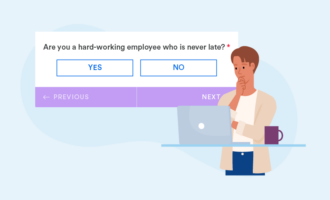Data plays a vital role in today’s world. We rely on it when we need to get something done or to understand issues like why groups behave in certain ways and tech companies continue to promise that better data analysis will change the world.
Yet, for all our hope and trust in data, many organizations are still using manual data entry — and costing themselves trillions of dollars globally as a result.
Why are we still doing manual data entry?
The short answer to that question is simply that we always have.
Business has always relied on data. As far back as 7,000 years ago, ancient civilizations kept records of business transactions, such as trades, purchases, and shipments of raw materials. For the next several thousand years, humans recorded data manually. Even when computers made their way into our businesses and lives, we still entered data into them by hand.
It wasn’t until very recently that we developed the tools for automated data entry. As a result, the vast majority of people, both workers and leadership, think of data entry as something humans do, using a computer as the tool. And the research bears that out — a global study revealed that employees spend over 40 percent of their working hours on manual digital administrative processes.
Although 46 percent of respondents to a McKinsey survey said that they’ve been prioritizing automation since the COVID-19 pandemic, changing our view of data entry from something we do into something artificial intelligence can do for us takes time. Yet every day we delay, we cost our own businesses money and growth.
The pitfalls of manual data entry
There’s one benefit to manual data entry: It feels familiar to workers who’ve entered data manually for most or all of their working lives.
But it presents one major drawback. It imposes costs — big costs — in a few key areas:
- Money: Manual data entry is expensive and comes with hidden costs. Those costs include payroll for workers who do manual data entry, investments in equipment for the work of manual data entry, and consequential loss of time and effort when errors in data entry lead to complications.
- Time: As of 2020, many application deployment and delivery decision-makers, who only had 27–35 percent of their tasks automated, reported feeling overwhelmed by their workload. Reallocating their time to tasks that actively contribute to the development of new products rather than the maintenance of existing ones could prove more effective.
- Mistakes: Manual data entry opens the door to errors, and these errors can have significant financial consequences. According to Quality Magazine, the average error rate of manual entry is one percent. While this may seem like a small amount, it can disrupt revenue streams and erode customer trust.
- Engagement: Employees who manually enter data often find the task repetitive and unengaging, which decreases their job satisfaction and productivity. Disengaged employees can negatively impact company culture and revenue.
- Compliance: It’s important for businesses to remain compliant with regulations relevant to their industry — and that starts with having accurate, secure data. Falling out of compliance can land companies in hot water in the event of an audit or data breach.
We’ve known for a while that manual systems that try to catch errors may reduce mistakes, but they add time and effort to the process. A 2023 study of four data processing methods in clinical trials found that double entry had the fewest errors compared to single entry, visual inspections, and medical record abstraction — but double entry requires more labor-hours, increasing the time spent on data entry and the costs of paying staff to do the work.
Types of manual data entry processes
The three main types of manual data entry processes include
- Paper-based forms
- Keyboard entry
- Scanning
Paper-based forms allow employees to work by hand, catering to individual working styles, but they can be challenging when you need to access the data electronically. When completed forms are scanned, issues such as hard-to-read handwriting, smudged ink, and physical blemishes may prevent scanning software from accurately identifying characters.
Keyboard entry involves an employee typing each individual number or letter into a spreadsheet or document. While this method can easily be outsourced, it’s time-consuming and leaves plenty of room for human error, resulting in data inaccuracies.
Scanning is the process of transferring data from a physical document into an electronic one, avoiding the need for someone to manually reenter information. Many printers come with a scanning function built in.
Reducing manual data entry with AI and intelligent document processing
AI software known as intelligent document processing, or IDP, converts unstructured data into a format that a machine can read, regardless of formatting differences between sources. Using this software can reduce the amount of time it takes for organizations to process documents from days to minutes.
This reduction is especially useful in the B2B space, where most transactions involve a lot of paperwork that must be reviewed and approved by multiple parties to maintain compliance with different regulations. PwC estimates that using AI to process documents can save 30–40 percent of the hours businesses spend on manual document processing.IDP can also offer analytics to companies so they can track their progress and make decisions based on data without the need for an employee to compile and analyze the data themselves. Automated data entry can improve data collection, allowing for better insights into how a business team, class of students, or other group is performing and what needs attention.
Reasons you should automate now
Manual data entry costs businesses trillions — literally. A 2018 Goldman Sachs report estimates that businesses incur over $2.7 trillion in B2B administrative costs annually, much of which is related to the use of paper checks for making payments.
The answer? Automation. Bain estimates that businesses that are “automation leaders,” meaning those that invested at least 20 percent of their IT budget into automation services, were able to save 17 percent on formerly manual processes, compared to only seven percent savings for companies that invested less than five percent.
Here are just a few benefits of automated data entry:
- Faster data entry: Automation allows a system or platform to fill in the blanks immediately — saving staff and customers from having to type the same information over and over again.
- Fewer mistakes: Because automation will copy the same information in the same way every time, it can’t introduce errors like transposed letters or misplaced decimals the way a fatigued or inattentive human might.
- More free time and focus: When staff don’t have to deal with the preliminaries of manual data entry, they can jump right into the part of a task that requires their expertise.
And you don’t have to build it from scratch: A number of free online forms enable your team to automate data entry as part of their ordinary, day-to-day tasks. Many of these forms look, feel, and operate just like the manual-entry forms already familiar to most of us, but they benefit from technology that allows for automated information management.
Automated data entry may be new, especially in the context of thousands of years of human writing and recordkeeping. But it doesn’t have to be daunting — and the benefits of abandoning manual data entry are vast.
Photo by Sebastian Pandelache on Unsplash































Send Comment: